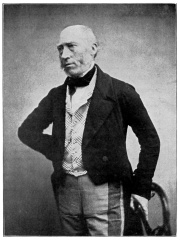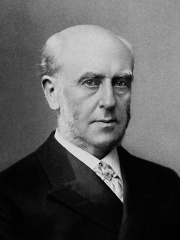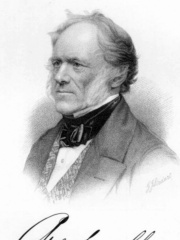


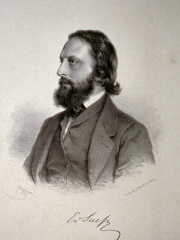
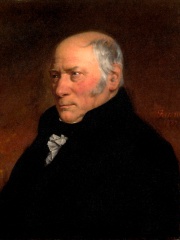
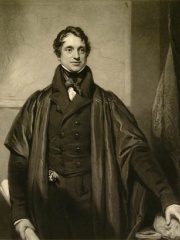
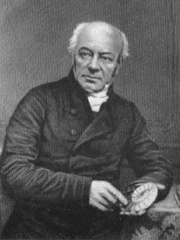
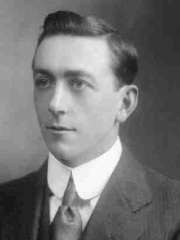
The Most Famous
GEOLOGISTS from United Kingdom
This page contains a list of the greatest British Geologists. The pantheon dataset contains 90 Geologists, 18 of which were born in United Kingdom. This makes United Kingdom the birth place of the most number of Geologists.
Top 10
The following people are considered by Pantheon to be the top 10 most legendary British Geologists of all time. This list of famous British Geologists is sorted by HPI (Historical Popularity Index), a metric that aggregates information on a biography's online popularity. Visit the rankings page to view the entire list of British Geologists.

1. Charles Lyell (1797 - 1875)
With an HPI of 71.72, Charles Lyell is the most famous British Geologist. His biography has been translated into 52 different languages on wikipedia.
Sir Charles Lyell, 1st Baronet, (14 November 1797 – 22 February 1875) was a Scottish geologist who demonstrated the power of known natural causes in explaining the earth's history. He is best known today for his association with Charles Darwin and as the author of Principles of Geology (1830–33), which presented to a wide public audience the idea that the earth was shaped by the same natural processes still in operation today, operating at similar intensities. The philosopher William Whewell dubbed this gradualistic view "uniformitarianism" and contrasted it with catastrophism, which had been championed by Georges Cuvier and was better accepted in Europe. The combination of evidence and eloquence in Principles convinced a wide range of readers of the significance of "deep time" for understanding the earth and environment. Lyell's scientific contributions included a pioneering explanation of climate change, in which shifting boundaries between oceans and continents could be used to explain long-term variations in temperature and rainfall. Lyell also gave influential explanations of earthquakes and developed the theory of gradual "backed up-building" of volcanoes. In stratigraphy his division of the Tertiary period into the Pliocene, Miocene, and Eocene was highly influential. He incorrectly conjectured that icebergs were the impetus behind the transport of glacial erratics, and that silty loess deposits might have settled out of flood waters. His creation of a separate period for human history, entitled the 'Recent', is widely cited as providing the foundations for the modern discussion of the Anthropocene. Building on the innovative work of James Hutton and his follower John Playfair, Lyell favoured an indefinitely long age for the earth, despite evidence suggesting an old but finite age. He was a close friend of Charles Darwin, and contributed significantly to Darwin's thinking on the processes involved in evolution. As Darwin wrote in On the Origin of Species, "He who can read Sir Charles Lyell's grand work on the Principles of Geology, which the future historian will recognise as having produced a revolution in natural science, yet does not admit how incomprehensibly vast have been the past periods of time, may at once close this volume." Lyell helped to arrange the simultaneous publication in 1858 of papers by Darwin and Alfred Russel Wallace on natural selection, despite his personal religious qualms about the theory. He later published evidence from geology of the time man had existed on the earth.

2. James Hutton (1726 - 1797)
With an HPI of 71.28, James Hutton is the 2nd most famous British Geologist. His biography has been translated into 56 different languages.
James Hutton ( ; 3 June O.S. 1726 – 26 March 1797) was a Scottish geologist, agriculturalist, chemical manufacturer, naturalist and physician. Often referred to as the "Father of Modern Geology," he played a key role in establishing geology as a modern science. Hutton advanced the idea that the physical world's remote history can be inferred from evidence in present-day rocks. Through his study of features in the landscape and coastlines of his native Scottish Lowlands, such as Salisbury Crags or Siccar Point, he developed the theory that geological features could not be static but underwent continuing transformation over indefinitely long periods of time. From this he argued, in agreement with many other early geologists, that the Earth could not be young. He was one of the earliest proponents of what in the 1830s became known as uniformitarianism, the science which explains features of the Earth's crust as the outcome of continuing natural processes over the long geologic time scale. Hutton also put forward a thesis for a 'system of the habitable Earth' proposed as a deistic mechanism designed to keep the world eternally suitable for humans, an early attempt to formulate what today might be called one kind of anthropic principle. Some reflections similar to those of Hutton can be found in publications of his contemporaries, such as the French naturalist Georges-Louis Leclerc de Buffon, but it is chiefly Hutton's pioneering work that established the field.

3. Mary Anning (1799 - 1847)
With an HPI of 70.94, Mary Anning is the 3rd most famous British Geologist. Her biography has been translated into 59 different languages.
Mary Anning (21 May 1799 – 9 March 1847) was an English fossil collector, dealer, and palaeontologist. She became known internationally for her discoveries in Jurassic marine fossil beds in the cliffs along the English Channel at Lyme Regis in the county of Dorset, Southwest England. Anning's findings contributed to changes in scientific thinking about prehistoric life and the history of the Earth. Anning searched for fossils in the area's Blue Lias and Charmouth Mudstone cliffs, particularly during the winter months when landslides exposed new fossils that had to be collected quickly before they were lost to the sea. Her discoveries included the first correctly identified ichthyosaur skeleton when she was twelve years old; the first two nearly complete plesiosaur skeletons; the first pterosaur skeleton located outside Germany; and fish fossils. Her observations played a key role in the discovery that coprolites, known as bezoar stones at the time, were fossilised faeces, and she also discovered that belemnite fossils contained fossilised ink sacs like those of modern cephalopods. Anning struggled financially for much of her life. As a woman, she was not eligible to join the Geological Society of London, and she did not always receive full credit for her scientific contributions. However, her friend, geologist Henry De la Beche, who painted Duria Antiquior, the first widely circulated pictorial representation of a scene from prehistoric life derived from fossil reconstructions, based it largely on fossils Anning had found and sold prints of it for her benefit. Anning became well known in geological circles in Britain, Europe, and America, and was consulted on issues of anatomy as well as fossil collecting. The only scientific writing of hers published in her lifetime appeared in the Magazine of Natural History in 1839, an extract from a letter that Anning had written to the magazine's editor questioning one of its claims. After her death in 1847, Anning's unusual life story attracted increasing interest.

4. Eduard Suess (1831 - 1914)
With an HPI of 70.69, Eduard Suess is the 4th most famous British Geologist. His biography has been translated into 43 different languages.
Eduard Suess (Austrian German: [ˈeːdu.ard ˈsyːs]; 20 August 1831 – 26 April 1914) was an Austrian geologist and a specialist on the geography of the Alps. He is responsible for hypothesising two major former geographical features, the supercontinent Gondwana (proposed in 1861) and the Tethys Ocean. He also introduced the concepts of eustasy. As a professor of geology at the University of Vienna, he was a founding figure in geology in Austria, influencing numerous geologists across Europe. He was considered the "dean of geology" at the beginning of the twentieth century. He was also an Austrian parliament representative for the liberal party.
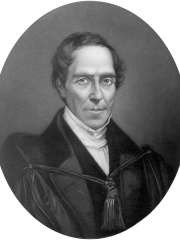
5. Gideon Mantell (1790 - 1852)
With an HPI of 65.77, Gideon Mantell is the 5th most famous British Geologist. His biography has been translated into 33 different languages.
Gideon Algernon Mantell MRCS FRS (3 February 1790 – 10 November 1852) was an English obstetrician, geologist and palaeontologist. His attempts to reconstruct the structure and life of Iguanodon began the scientific study of dinosaurs: in 1822 he was responsible for the discovery (and the eventual identification) of the first fossil teeth, and later much of the skeleton, of Iguanodon. Mantell's work on the Cretaceous of southern England was also important.

6. William Smith (1769 - 1839)
With an HPI of 65.26, William Smith is the 6th most famous British Geologist. His biography has been translated into 37 different languages.
William 'Strata' Smith (23 March 1769 – 28 August 1839) was an English geologist, credited with creating the first detailed, nationwide geological map of any country. At the time his map was first published he was overlooked by the scientific community; his relatively humble education and family connections prevented him from mixing easily in learned society. Financially ruined, Smith spent time in debtors' prison. It was only late in his life that Smith received recognition for his accomplishments, and became known as the "father of English geology".

7. Adam Sedgwick (1785 - 1873)
With an HPI of 65.25, Adam Sedgwick is the 7th most famous British Geologist. His biography has been translated into 32 different languages.
Adam Sedgwick FRS (; 22 March 1785 – 27 January 1873) was a British geologist and Anglican priest, one of the founders of modern geology. He proposed the Cambrian and Devonian period of the geological timescale. Based on work which he did on Welsh rock strata, he proposed the Cambrian period in 1835, in a joint publication in which Roderick Murchison also proposed the Silurian period. Later in 1840, to resolve what later became known as the Great Devonian Controversy about rocks near the boundary between the Silurian and Carboniferous periods, he and Murchison proposed the Devonian period. Though he had guided the young Charles Darwin in his early study of geology and continued to be on friendly terms, Sedgwick was an opponent of Darwin's theory of evolution by means of natural selection. He strongly opposed the admission of women to the University of Cambridge, in one conversation describing aspiring female students as "nasty forward minxes."

8. William Buckland (1784 - 1856)
With an HPI of 62.13, William Buckland is the 8th most famous British Geologist. His biography has been translated into 43 different languages.
William Buckland DD, FRS (12 March 1784 – 14 August 1856) was an English theologian, geologist and palaeontologist. His work in the early 1820s proved that Kirkdale Cave in North Yorkshire had been a prehistoric hyena den, for which he was awarded the Copley Medal. It was praised as an example of how scientific analysis could reconstruct events in the distant past. He pioneered the use of fossilised faeces in reconstructing ecosystems, coining the term coprolites. Buckland also wrote the first full account of a fossil dinosaur, which he named Megalosaurus in 1824. Buckland followed the Gap Theory in interpreting the biblical account of Genesis as two widely separated episodes of creation. It had emerged as a way to reconcile the scriptural account with discoveries in geology suggesting the earth was very old. Early in his career Buckland believed he had found evidence of the biblical flood, but later saw that the glaciation theory of Louis Agassiz gave a better explanation, and played a significant role in promoting it. Buckland served as Dean of Westminster from 1845 until his death 1856.

9. Arthur Holmes (1890 - 1965)
With an HPI of 60.40, Arthur Holmes is the 9th most famous British Geologist. His biography has been translated into 24 different languages.
Arthur Holmes (14 January 1890 – 20 September 1965) was an English geologist who made two major contributions to the understanding of geology. He pioneered the use of radiometric dating of minerals, and was the first earth scientist to grasp the mechanical and thermal implications of mantle convection, which led eventually to the acceptance of plate tectonics.
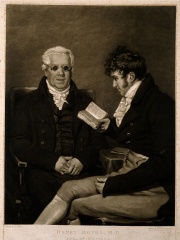
10. William Nicol (1770 - 1851)
With an HPI of 56.94, William Nicol is the 10th most famous British Geologist. His biography has been translated into 16 different languages.
William Nicol FRSE FCS (1768? – 2 September 1851) was a Scottish geologist and physicist who invented the Nicol prism, the first device for obtaining plane-polarized light, in 1828.
People
Pantheon has 18 people classified as British geologists born between 1726 and 1942. Of these 18, 1 (5.56%) of them are still alive today. The most famous living British geologists include Dan McKenzie. The most famous deceased British geologists include Charles Lyell, James Hutton, and Mary Anning.
Living British Geologists
Go to all RankingsDeceased British Geologists
Go to all RankingsCharles Lyell
1797 - 1875
HPI: 71.72
James Hutton
1726 - 1797
HPI: 71.28
Mary Anning
1799 - 1847
HPI: 70.94
Eduard Suess
1831 - 1914
HPI: 70.69
Gideon Mantell
1790 - 1852
HPI: 65.77
William Smith
1769 - 1839
HPI: 65.26
Adam Sedgwick
1785 - 1873
HPI: 65.25
William Buckland
1784 - 1856
HPI: 62.13
Arthur Holmes
1890 - 1965
HPI: 60.40
William Nicol
1770 - 1851
HPI: 56.94
John Phillips
1800 - 1874
HPI: 56.71
Archibald Geikie
1835 - 1924
HPI: 56.59
Overlapping Lives
Which Geologists were alive at the same time? This visualization shows the lifespans of the 17 most globally memorable Geologists since 1700.


